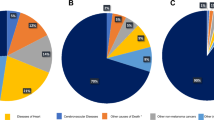Abstract
This study examined time trends and age-period-cohort patterns in the incidence of cutaneous malignant melanoma (CMM) by gender and anatomic site in Connecticut (United States) between 1950 and 1989, using data from the population-based Connecticut Tumor Registry. A total of 8,249 invasive CMM incident cases were included. Cases were grouped into melanomas of the head and neck, upper limb, lower limb, and trunk. Between 1950 and 1989, rates increased substantially for all sites. The largest relative increases occurred in melanoma of the upper limb for both males and females; the largest absolute increase occurred for melanoma of the trunk in males; and the smallest increase occurred in head and neck melanoma in females. Recent trends for time periods 1970–89 among birth cohorts 1930–69 indicated that the rate of increase of CMM is slowing substantially among males, but not among females. Nevertheless, continued overall increases in CMM incidence are likely in Connecticut in the 1990s in both genders, with a decrease in the male-female ratio. The age-period-cohort patterns were significantly different between the genders and among anatomic sites, suggesting different trends in carcinogenic exposures (mainly ultraviolet radiation from the sun) or etiologic distinctions between males and females and among the sites.
Similar content being viewed by others
References
Jensen OM, Bolander AM. Trends in malignant melanoma of the skin.World Health Stat 1980;33: 3–26.
Roush GC, Holford TR, Schymura MJ, White C.Cancer Risk and Incidence Trends. The Connecticut Perspective. Washington, DC (US): Hemisphere Publishing, 1987.
MacLennan R, Green AC, McLeod GRC, Martin NG. Increasing incidence of cutaneous melanoma in Queensland, Australia.JNCI 1992;84: 1427–32.
Osterlind A, Engholm G, Jensen OM. Trends in cutaneous malignant melanoma in Denmark 1943–1982 by anatomic sites.APMIS 198896: 953–63.
Thorn M, Bergstrom R, Adami H-O, Ringborg U. Trends in the incidence of malignant melanoma in Sweden, by anatomic site, 1960–1984.Am J Epidemiol 1990;132: 1066–77.
Magnus K. Habits of sun exposure and risk of malignant melanoma: An analysis of incidence rates in Norway 1955–1977 by cohort, sex, age, and primary tumor site.Cancer 1981;48: 2329–35.
Houghton A, Flannery J, Viola MV. Malignant melanoma in Connecticut and Denmark.Int J Cancer 1980;25: 95–104.
Stevens RG, Moolgavkar SH. Malignant melanoma: dependence of site-specific risk on age.Am J Epidemiol 1984;119: 890–5.
Boyle P, Day N, Magnus K. Mathematical modeling of malignant melanoma trends in Norway, 1953–1978.Am J Epidemiol 1983;118: 887–96.
Roush GC, Schymura MJ, Holford TR. Patterns of invasive melanoma in the Connecticut Tumor Registry: Is the long-term increase real?Cancer 1988;61: 2586–95.
Dennis LK, White E, Lee JAH. Recent cohort trends in malignant melanoma by anatomic site in the United States.Cancer Causes Control 1993;4: 93–100.
Heston JF, Kelly JAB, Meigs JW, Flannery JT. Forty-five years of cancer incidence in Connecticut 1935–1979.NCI Monogr 1986;70: 1–31.
World Health Organization.International Classification of Diseases for Oncology. 1st edn. Geneva, Switzerland: World Health Organization, 1976.
International Agency for Research on Cancer and the National Cancer Institute.International Classification of Diseases for Oncology, Field Trial Edition. Lyon, France: IARC, 1986.
Holford TR. Understanding the effects of age, period, and cohort on incidence and mortality rates.Ann Rev Public Health 1991;12: 425–47.
Baker RG, Nelder JA.The GLIM system: Release 3. Oxford, UK: Numerical Algorithms Group, 1978.
Clayton D, Schifflers E. Models for temporal variation in cancer rates. I. Age-period and age-cohort models.Stat Med 1987;6: 449–67.
Clayton D, Schifflers E. Models for temporal variation in cancer rates. II. Age-period and age-cohort models.Stat Med 1987;6: 469–81.
Green A, MacLennan R, Youl P, Martin N. Site distribution of cutaneous melanoma in Queensland.Int J Cancer 1993;53: 232–6.
Osterlind A, Hou-Jensen K, Jensen OM. Incidence of cutaneous malignant melanoma in Denmark 1978–1982. Anatomic site distribution, histologic type, and comparison with non-melanoma skin cancer.Br J Cancer 1988;58: 385–91.
Scotto J, Pitcher H, Lee JAH. Indications of future decreasing trends in skin-melanoma mortality among Whites in the United States.Int J Cancer 1991;49: 490–7.
van der Esch EP, Muir CS, Nectoux J, et al. Temporal change in diagnostic criteria as a cause of the increase of malignant melanoma over time is unlikely.Int J Cancer 1991;47: 483–90.
Koh HK. Cutaneous melanoma.N Engl J Med 1991;325: 171–82.
Armstrong BK. Epidemiology of melanoma: intermittent or total accumulated exposure to the sun?J Dermatol Surg Oncol 1988;14: 835–49.
Young SW. A list of photosensitizing agents of interest to the dermatologist.Bull Assoc Milit Derm, 1964;13: 33–5.
Lamberg SI. A new photosensitizer.JAMA 1967;201: 121–4.
Ashwood-Smith MJ. Possible cancer hazard associated with 5-methoxypsoralen in suntan preparationsBr Med J 1979;2: 1144.
Stoica A, Hoffman M, Marta L, Voiculetz N. Estradiol and progesterone receptors in human cutaneous melanoma.Neoplasma 1991;38: 137–45.
Osterlind A. Hormonal and reproductive factors in melanoma risk.Clin Dermatol 1992;10: 75–8.
Walter SD, Marrett LD, Shannon HS, Form L, Hertzman C. The association of cutaneous malignant melanoma and fluorescent light exposure.Am J Epidemiol 1992;135: 749–62.
Elwood JM. Could melanoma be caused by fluorescent light? A review of relevant epidemiology.Rec Res Cancer Res 1985;102: 127–36.
Walter SD, Marrett LD, Form L, Hertzman C, Shannon HS, Roy P. The association of cutaneous malignant melanoma with the use of sunbeds and sunlamps.Am J Epidemiol 1990;131: 232–43.
Clark WH Jr, Mihm MC Jr. Lentigo maligna and lentigo-maligna melanoma.Am J Pathol 1969;55: 39.
Green A. A theory of site distribution of melanomas: Queensland, Australia.Cancer Causes Control 1992;3: 513–6.
Author information
Authors and Affiliations
Additional information
This study was supported by the National Institute of Health grant # CA-62986, and #CA-30931. Dr Dubrow received support from a National Cancer Institute Preventive Oncology Academic Award (K07-CA01463).
Rights and permissions
About this article
Cite this article
Chen, YT., Zheng, T., Holford, T.R. et al. Malignant melanoma incidence in Connecticut (United States): time trends and age-period-cohort modeling by anatomic site. Cancer Causes Control 5, 341–350 (1994). https://doi.org/10.1007/BF01804985
Received:
Accepted:
Issue Date:
DOI: https://doi.org/10.1007/BF01804985




